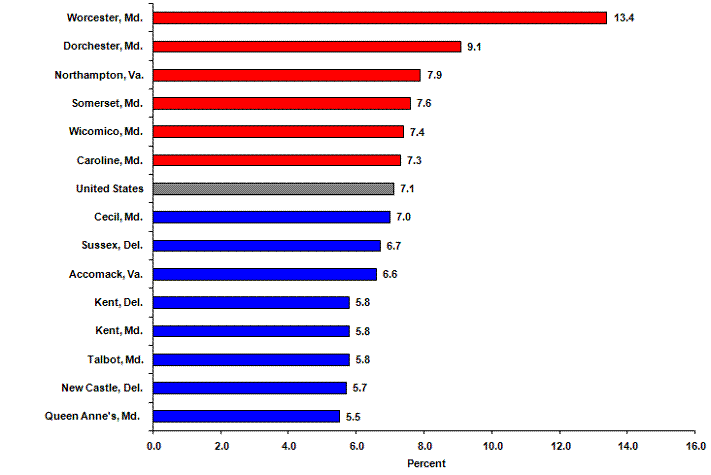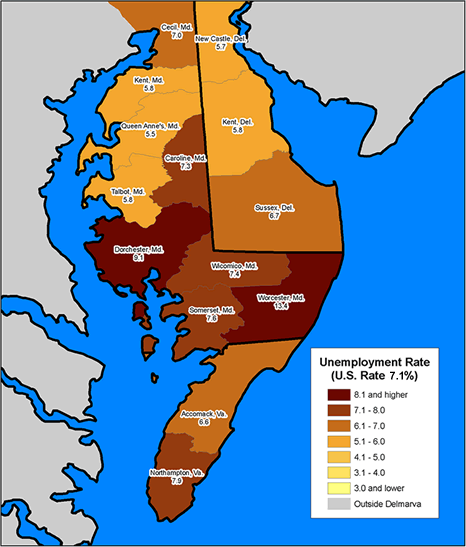| Web site : www.bls.gov/ro3/ | PLS - 4503 For Release: Tuesday, March 3, 2009 |
|||||||||||||||||||||||||||||||||||||||||||||||||||||||||||||||||||||||||||||||||||||||||||||||||||||||||||||||||||||||||||
| Information: | Gerald Perrins (215) 597-3282 |
|||||||||||||||||||||||||||||||||||||||||||||||||||||||||||||||||||||||||||||||||||||||||||||||||||||||||||||||||||||||||||
| Media Contact: | Sheila Watkins (215) 861-5600 |
|||||||||||||||||||||||||||||||||||||||||||||||||||||||||||||||||||||||||||||||||||||||||||||||||||||||||||||||||||||||||||
UNEMPLOYMENT ON THE DELMARVA PENINSULA BY COUNTY: DECEMBER 2008 (PDF)All Delmarva Counties Posted Unemployment Rates Higher than a Year EarlierIn December, Queen Anne’s County, Md., reported the lowest county unemployment rate on the Delmarva Peninsula, at 5.5 percent. The next lowest rates were reported in New Castle County, Del. (5.7 percent), closely followed by Kent County, Del., Kent County, Md., and Talbot County Md. (each at 5.8 percent), according to the Bureau of Labor Statistics of the U.S. Department of Labor. Sheila Watkins, the Bureau’s regional commissioner, noted that six counties registered unemployment rates above the national average of 7.1 percent, with the highest rates in Worcester County, Md. (13.4 percent), and Dorchester County, Md. (9.1 percent). The remaining eight counties registered jobless rates that were lower than that of the nation. (See chart A.) Chart A. Unemployment rates for the United States and counties on the Delmarva Peninsula, December 2008, not seasonally adjusted
All 14 counties located on the Delmarva Peninsula had unemployment rates that were higher in December 2008 than a year earlier. Twelve counties recorded rate increases larger than the 2.3-percentage points national increase, led by Worcester, Md. (+4.6 points), and Northampton, Va. (+3.3 points). Two counties had increases less than the national average, Accomack, Va. (+1.6 points), and Talbot, Md. (+2.2 points). (See table A.)
Similar to the comparison with December 2007 rates, the December 2008 unemployment rates on the Delmarva Peninsula were also higher across the board than those of December 2002, 13 months after the end of the last recession. The county with the largest net unemployment rate increase was Worcester County in Maryland (+4.2 percent), where the rate rose from 9.2 percent in December 2002 to 13.4 percent in December 2008—the highest unemployment rate in nine years. Somerset County, Md. (+0.9 percent), reported the smallest rate increase during the same period, from 6.7 percent in December 2002 to 7.6 percent in December 2008. Unemployment rates in the 14 counties on the Delmarva Peninsula were generally higher in December than those of the individual states in which the counties were located. The three states all recorded rates below the United States—5.1 percent in Virginia, 5.5 percent in Maryland, and 5.9 percent in Delaware. On the peninsula, however, unemployment rates in Virginia’s two counties were both well above the Commonwealth’s 5.1-percent rate. In Maryland, eight of the nine Delmarva counties had jobless rates exceeding the State’s 5.5-percent figure, while Queen Anne’s County had a rate that matched that of the State. Delaware’s three counties are all part of the Delmarva Peninsula, so no other county impacts the State’s jobless rate. Sussex County was the only one to report an unemployment rate above that of the State in December 2008. Technical NotesThis release presents unemployment rate data for states and counties from the Local Area Unemployment Statistics (LAUS) program, a federal-state cooperative endeavor. Definitions. The labor force and unemployment data are based on the same concepts and definitions as those used for the official national estimates obtained from the Current Population Survey (CPS), a sample survey of households that is conducted for the Bureau of Labor Statistics (BLS) by the U.S. Census Bureau. The LAUS program measures employment and unemployment on a place-of-residence basis. The universe for each is the civilian noninstitutional population 16 years of age and over. Employed persons are those who did any work at all for pay or profit in the reference week (the week including the 12th of the month) or worked 15 hours or more without pay in a family business or farm, plus those not working who had a job from which they were temporarily absent, whether or not paid, for such reasons as labor-management dispute, illness, or vacation. Unemployed persons are those who were not employed during the reference week (based on the definition above), had actively looked for a job sometime in the 4-week period ending with the reference week, and were currently available for work; persons on layoff expecting recall need not be looking for work to be counted as unemployed. The labor force is the sum of employed and unemployed persons. The unemployment rate is the number of unemployed as a percent of the labor force. Method of estimation. Estimates for 48 of the 50 states, the District of Columbia, the Los Angeles-Long Beach-Glendale metropolitan division, New York City, and the balances of California and New York State are produced using estimating equations based on regression techniques. This method, which underwent substantial enhancement at the beginning of 2005, utilizes data from several sources, including the CPS, the Current Employment Statistics (CES), and state unemployment insurance (UI) programs. Estimates for the substate areas in this release are prepared through indirect estimation procedures using a building-block approach. Employment estimates, which are based largely on "place of work" estimates from the CES program, are adjusted to refer to place of residence as used in the CPS. Unemployment estimates are aggregates of persons previously employed in industries covered by state UI laws and entrants to the labor force data from the CPS. The substate estimates of employment and unemployment, which geographically exhaust the entire state, are adjusted proportionally to ensure that they add to the independently estimated state or balance-of-state totals. A detailed description of the estimation procedures is available from BLS upon request. Annual revisions. Labor force and unemployment data for prior years reflect adjustments made at the end of each year. The adjusted estimates reflect updated population data from the U.S. Census Bureau, any revisions in the other data sources, and model reestimation. In most years, historical data for the most recent five years (both seasonally adjusted and not seasonally adjusted) are revised near the beginning of each calendar year, prior to or coincident with the release of January estimates. Information in this release will be made available to sensory impaired individuals upon request. Voice phone: (202) 691-5200; TDD message referral phone: 1-800-877-8339. For personal assistance or further information on the Local Area Unemployment Statistics data, as well as other Bureau data, contact the Mid-Atlantic Information Office at 215-597-3282 from 8:30 a.m. to 12:00 p.m. and 1:00 p.m. to 3:30 p.m. ET. Information on the Local Area Unemployment Statistics program and other surveys and programs is available on our Web site at www.bls.gov/ro3/.
|
||||||||||||||||||||||||||||||||||||||||||||||||||||||||||||||||||||||||||||||||||||||||||||||||||||||||||||||||||||||||||||
Chart 1. Unemployment rates for counties on the Delmarva Peninsula, not seasonally adjusted, December 2008
Last Modified Date: March 3, 2009
Quick Links
Tools |
Calculators |
Help |
Info |


